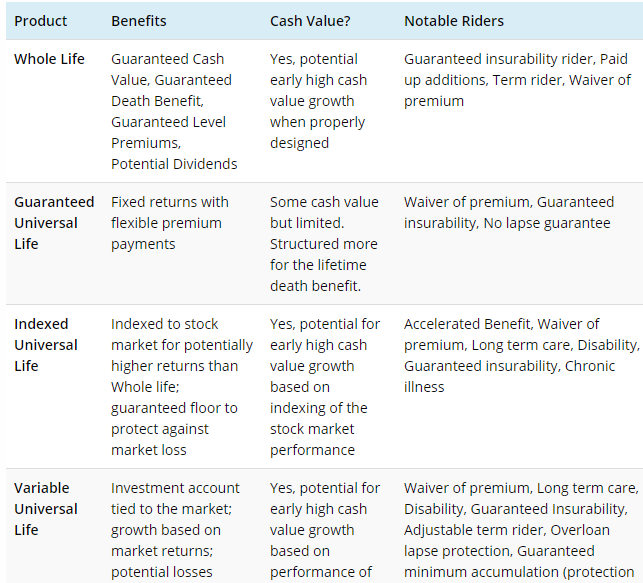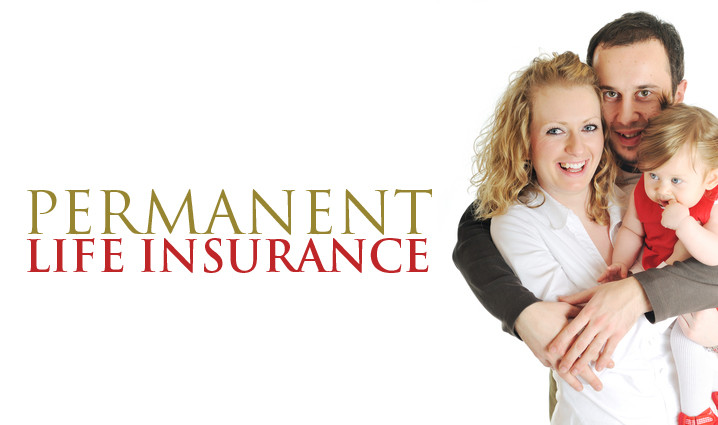Permanent Life Insurance is also called “cash value insurance”. This means a permanent policy builds up cash value over time. There are 2 types of permanent policies on the market today. They are:
- Whole Life Insurance and Final Expense
- Universal Life Insurance (There are 3 variations of universal life: Guaranteed Universal Life, Indexed Universal Life, and Variable Life)
Permanent life insurance can be a great asset to have in your financial toolbox. In this article, I will explain the different types of permanent life insurance along with the pros and cons of each one.
What is Permanent Life Insurance?
This type of life insurance is just like it sounds, PERMANENT. This policy does not expire and depending on which type of permanent policy you purchase, most have a guaranteed premium. These policies due build up cash value and earn interest. How much cash value and interest all depends on the type of permanent policy you choose. Below is a table that will give you a brief breakdown:

Advantages of Permanent Life Insurance
The major advantages of buying a permanent life insurance policy are the death benefit, cash value growth, and you lock in the premium.
- The death benefit on permanent policies are guaranteed for the life of the policy. They cannot be decreased unless you request this. The death benefits of these policies run to age 120
- The cash value growth can vary depending on the policy you pick. Whole life can earn dividends along with guaranteed cash value while universal life has a variety of ways to earn interest. With universal life policies you can even be invested in the market.
- When you purchase your permanent policies (most of them anyways) you lock in the premium at that age. It cannot go up (most of them don’t) for the life of the policy
- Withdrawals & Loans- The cash value of permanent life insurance policies grow tax deferred and usually can be withdrawn or taken out as a loan without any tax implications
Drawbacks to Permanent Life Insurance
- The price of permanent life insurance policies is the biggest drawback. Term life insurance is going to be much cheaper, but it will expire at some point.
- Longevity is also an issue for some clients. Some clients feel they will only need the coverage for a certain time frame. They don’t want to invest all that money just to cancel policy later on down the road.
Types of Permanent Life Insurance
As seen earlier in the chart there are several different types of permanent insurance to choose from. In the next section we will dive into that.
Whole Life Insurance:
Often referred to as ordinary life insurance, whole life insurance was the first insurance policy written in the United States. Whole life insurance provides coverage for the life of the policy (age 121).
Whole life insurance policies build a guaranteed cash value set by the carrier and listed in the contract. Some policies, called participating whole life, also receive dividends along with the guaranteed cash value.
These dividends can be used to buy extra life insurance, accumulate, or be withdrawn. One of whole life’s key setback is the price. Whole life can be expensive compared to other types of policies.
There are 4 types of whole life insurance polices to choose from:
- Non-Participating Whole Life– This is your traditional whole life insurance policy. Comes with a guaranteed premium, guaranteed death benefit, and guaranteed cash value. This whole life policy does not earn dividends.
- Participating Whole Life- Has the same features as the traditional whole life policy except participating whole life does earn dividends.
- Final Expense or Burial Insurance-Final Expense Insurance is issued to consumers ages 45-85 with a limited death benefit allowed, usually up to $50,000. Underwriting for these products allows for consumers who have less than perfect health.
- Guaranteed Issue Whole Life: This is a no medical questions, guaranteed issue whole life policy. Issue ages are from 50-80 with face amounts up to $25,000.
Universal Life Insurance
Universal life insurance is a permanent life policy that that has a term life element along with investment savings option. Universal life is also called adjustable life insurance. There are 3 types of universal life policies sold today and all 3 calculate how interest is earned differently. Let me explain:
- Guaranteed Universal Life: This type of universal life insurance is most like a whole life insurance policy. The premium is guaranteed for the life of the policy just like whole life. The cash value accumulation will be minuscule compare to a whole life policy. Usually the declared interest rates in these policies are about 3%. With that said, the premium on the guaranteed universal life policies are much cheaper than a whole life.
- Indexed Universal Life: These types of universal life insurance policies are different because of the way they calculate the interest earned. The interest earned is tied to an equity index, such as S&P 500. A cap is declared at the beginning of each policy year, which means the company caps what you make. There is also a floor of usually 0% (Some companies it’s 1%), which means if the index is in the negative, you don’t lose any money. Also, the interest earned each year locks in on your anniversary date. Most of these policies don’t come with a guaranteed premium and this could be a problem down the road if not funded properly. The good thing is some companies do offer a guaranteed premium.
- Variable Universal Life: This is the most controversial of the universal life policies and with just cause. These policies cash value are tied to sub accounts which are very similar to mutual funds. These accounts have no floor, so no protection, and are able to lose money. Sometimes big money. The premiums are never guaranteed on these policies which usually always leads to a premium increase down the road. I personal don’t recommend this type of universal life policy.
My thoughts
Personally, I always recommend a permanent policy if it fits in my client’s budget. I have found that most people want life insurance to be there when they need it the most and a permanent policy can do this. When you buy term, it seems like a 50% chance that it will pay out, but that assumption would be wrong.
Term life insurance pays out about 2% in claims on average. See why permanent insurance maybe right for you. The key to getting a manageable premium when buying permanent life insurance is to not wait. The younger you are the cheaper it is. If you have any questions or comments, please give us a call or leave a comment.

